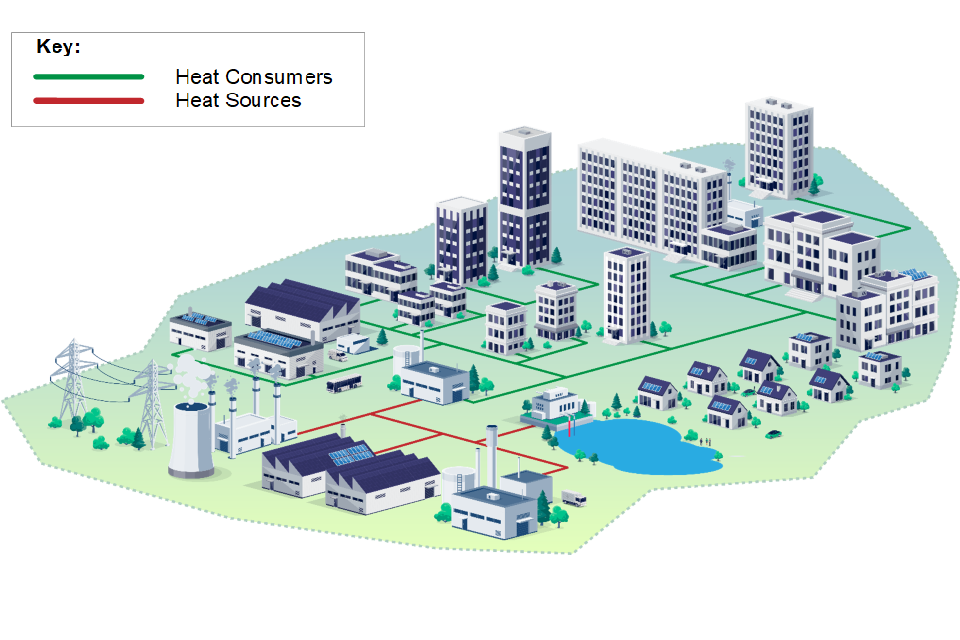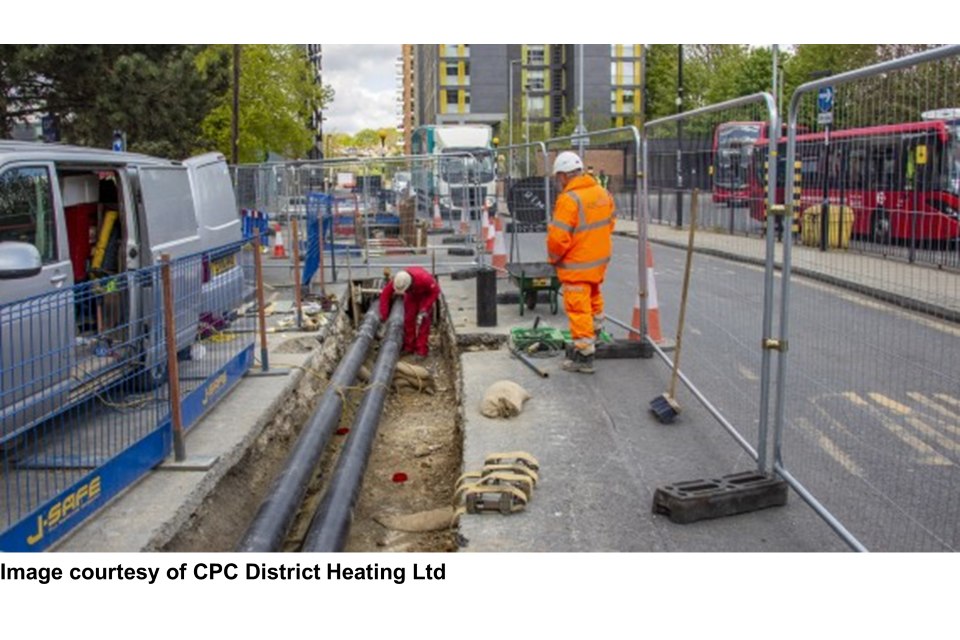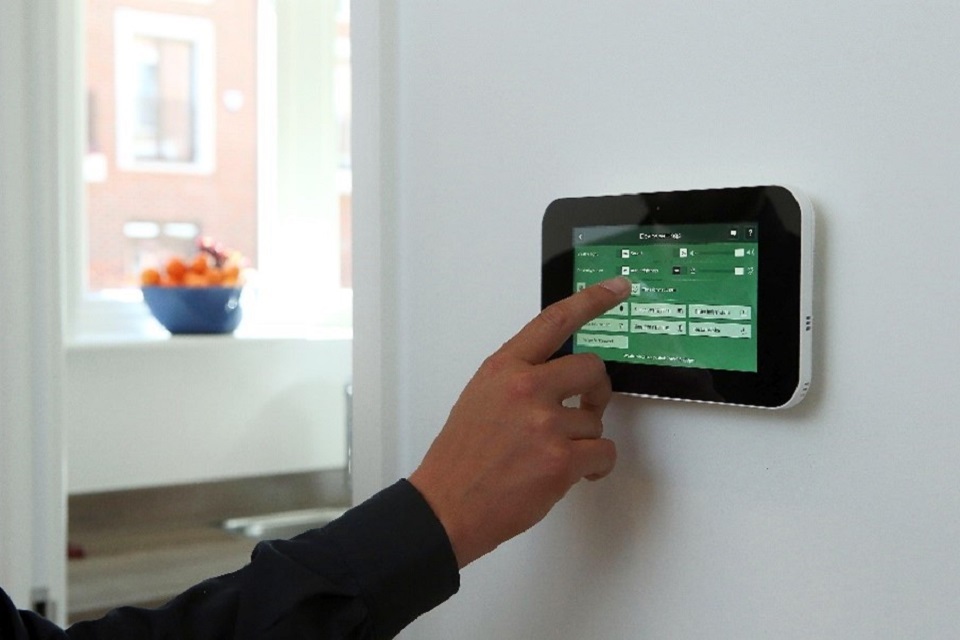Heat network zoning: overview
Published 12 January 2024
Enabling the accelerated roll-out of heat networks to provide a secure supply of
low-cost, low-carbon heat to consumers in England.
What is a heat network?

Photo credit: Vital Energi
Heat networks use insulated underground pipes to distribute heat from centralised sources to a variety of different customers, such as public buildings, shops, offices, hospitals, universities, and homes. This could be across entire cities or to a selection of neighbouring buildings.
These highly efficient systems remove the need for individual boilers or heaters in each building and can utilise local sources of low carbon heat - which would otherwise go to waste.
They are one of the most cost-effective ways of providing secure, reliable, and affordable heat to consumers and help us end our reliance on fossil fuels while cutting customer bills.
In 2023, around 2-3% of heat in the UK is provided by heat networks. It is estimated that heat networks will need to be supplying almost 20% of heat by 2050 to enable the UK to reach net zero.
Heat network zoning
Heat network zoning will fundamentally transform the development of new heat networks in towns and cities across England. By designating geographic zones where heat networks are expected to be the lowest cost solution for decarbonising heat, it will give local communities the tools to accelerate the development of heat networks and ensure that more homes and businesses can have access to greener, cheaper heat.

Through heat network zoning, certain types of buildings and low carbon heat sources can be required to connect to a network within a prescribed timeframe. By identifying, and ultimately connecting, the largest consumers of heat within a given area, a critical mass can be reached and provide the certainty needed to support long-term investment in heat networks.
These consumers could include:
- new buildings
- non-domestic buildings above an agreed size and energy use threshold
- buildings that are already communally heated
There will be some exemptions to this – such as where it would not be cost-effective to connect to a heat network or where a better low carbon solution exists. All of this will be confirmed in legislation.
Homes within zones which are not already communally heated will not be required to connect. However, should they wish to, they will be able to.
Developing heat network zones across the country will require tens of billions of pounds of investment and has the potential to create tens of thousands of jobs. Local authorities and heat network developers will work closely together to build new networks and deliver a low carbon heating revolution across the country.
The Department for Energy Security and Net Zero is working with a wide range of partners to deliver this transformation which has several key elements.
Why we are delivering heat network zoning
By identifying areas where heat networks are expected to be the lowest cost, low carbon heating option, buildings within the zones will benefit from a national framework that has assessed their best options to decarbonise their heating.
Furthermore, heat networks provide flexibility and security of heat supply as they can deliver heat provided from a variety of different sources. The flexibility will avoid some of the cost of enlarging our electricity grid for net-zero and means that heat networks are futureproofed as different heat sources emerge in the future.
Heat networks also work best when they have many different types of buildings connected. This results in greater efficiencies, which helps lower the cost of low carbon heat for everyone connected to the network.
In creating heat network zones where certain buildings will be required to connect, we can ensure that the required economies of scale are reached within each zone identified, which will provide the best outcomes for everyone connected.
Heat network zones will also provide project sponsors and developers with the certainty about connections that will be required to secure the investment for construction.
Our approach
The Energy Act 2023 provides the powers for government to implement heat network zoning in England.
Following an initial public consultation in 2021, we are consulting further on the finer details of zoning. This will include what types of buildings will be required to connect, how zone opportunities will be developed and the respective role of central and local government in delivering zoning.
Identifying locations for heat network zones
We are developing a methodology to identify potential heat network zones in a consistent manner in towns and cities across the country. This process will include using data from a variety of sources, such as the building type, size, and existing energy usage.
We are working with 28 English cities and towns in a pilot project to refine and test the proposed methodology. The findings from the pilot will be used to finalise the model for identifying potential heat network zones.
We are also developing a cutting-edge digital tool to provide detailed maps and information on the proposed zones and enable various stakeholders to identify where they may be able to access lowest-cost low-carbon heat from a proposed network.

Example map (for illustrative purposes and not representative of a final zone)
The process
A new Heat Network Zoning Authority, based within central government, will oversee the implementation of heat network zoning and set national standards. Local zoning co-ordinators will also be established with responsibility for designating areas as heat network zones and enforcing requirements within them. We propose that these will be teams working within local government.
When the national modelling process has identified a potential heat network zone in a town or city, the zoning co-ordinators will play an important role in refining the zone boundaries and consider local factors. This will ensure the best outcome for each zone is identified reflecting local circumstances.
In some areas, there may not be a relevant organisation able to take on the role of zoning co-ordinator. In this situation, the Heat Network Zoning Authority will adopt the co-ordinator role.
We are also exploring the potential to provide standardised routes for the delivery of heat networks in zones, enabling each zone co-ordinator to quickly access technical, legal, and commercial guidance and a range of standard contracts. This will reduce costs and ensure a consistent approach across the country.

Learning from pilot projects
Our work in piloting heat network zones ahead of the introduction of the legislation in 2025, coupled with the development of a range of support measures and resources for zoning co-ordinators, will enable a number of zones to start construction by the end of 2025.
Protecting consumers

Image courtesy of Energetik
Alongside heat network zoning, comprehensive consumer protection regulation of the heat network sector will be put into place through the Heat Network Market Framework. [footnote 1]
Ofgem is taking on the role of regulator and will have new powers to regulate prices in the sector and investigate disproportionate pricing across all heat networks.
Within the sector, this will secure fair pricing for domestic customers as well as ensuring transparency, guaranteed standards of performance and other protections, providing market assurance and encouraging investment in the industry. Regulations also extend to technical and performance standards, to ensure that heat networks provide the highest levels of service and reliability for connected consumers.
Further information
Should you wish to be kept up to date as to the progress of heat network zoning and find out about future events and other related news, you can subscribe to our email newsletter where you can select from a range of heat-network-related topics, that includes zoning.
Further information and resources for heat networks can also be found by visiting our heat network collection page on the gov.uk website.
